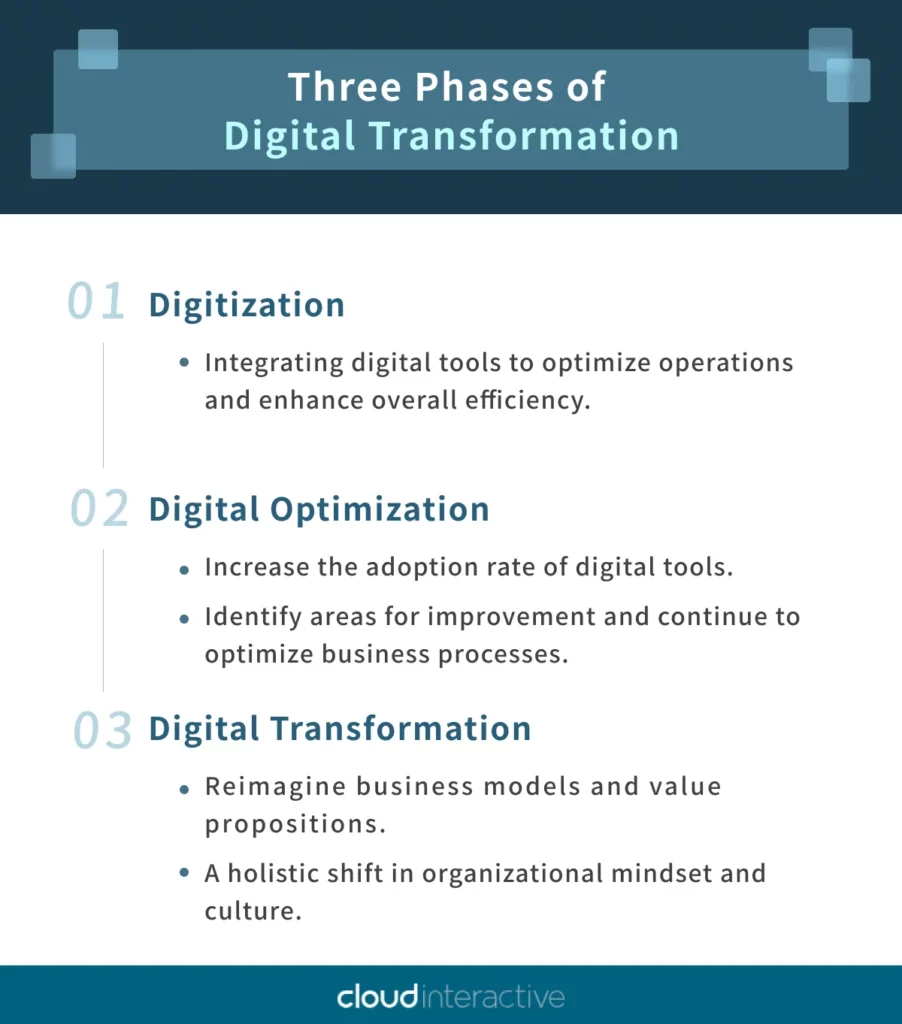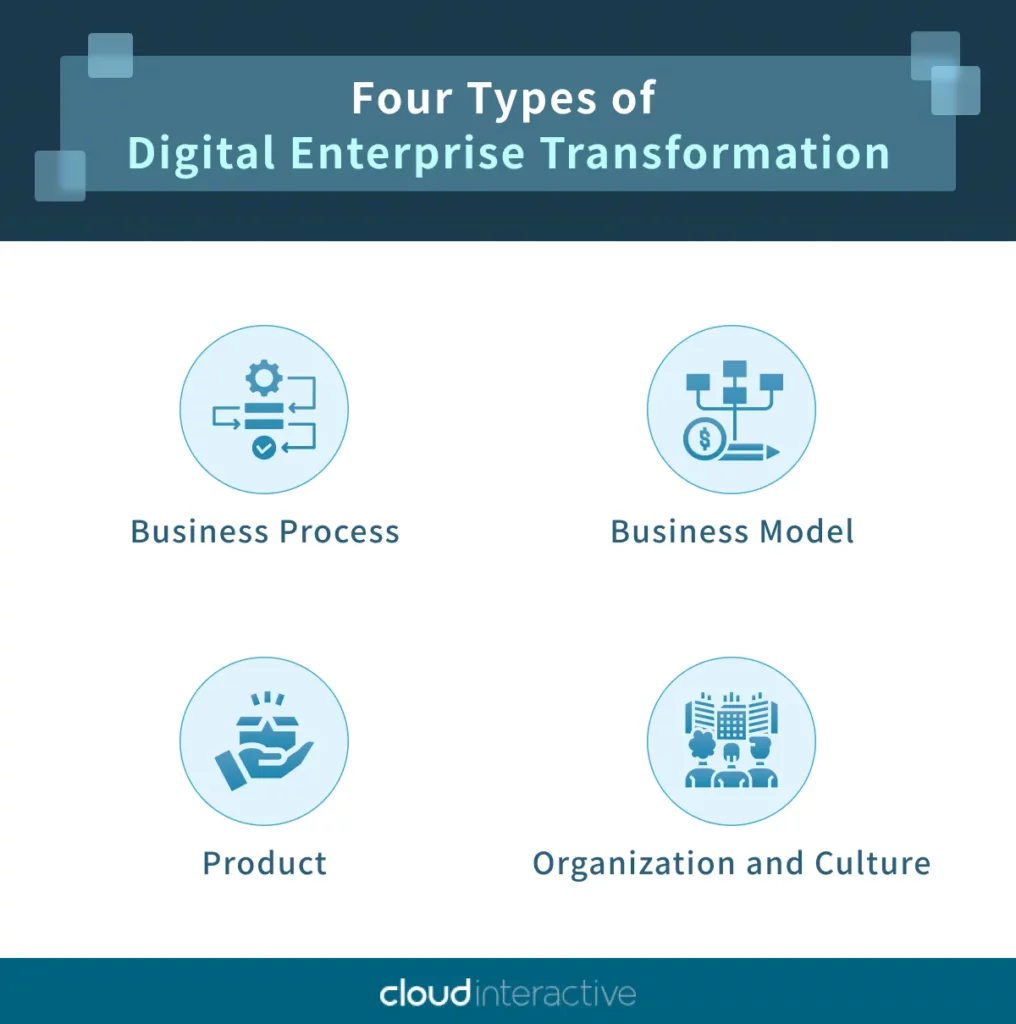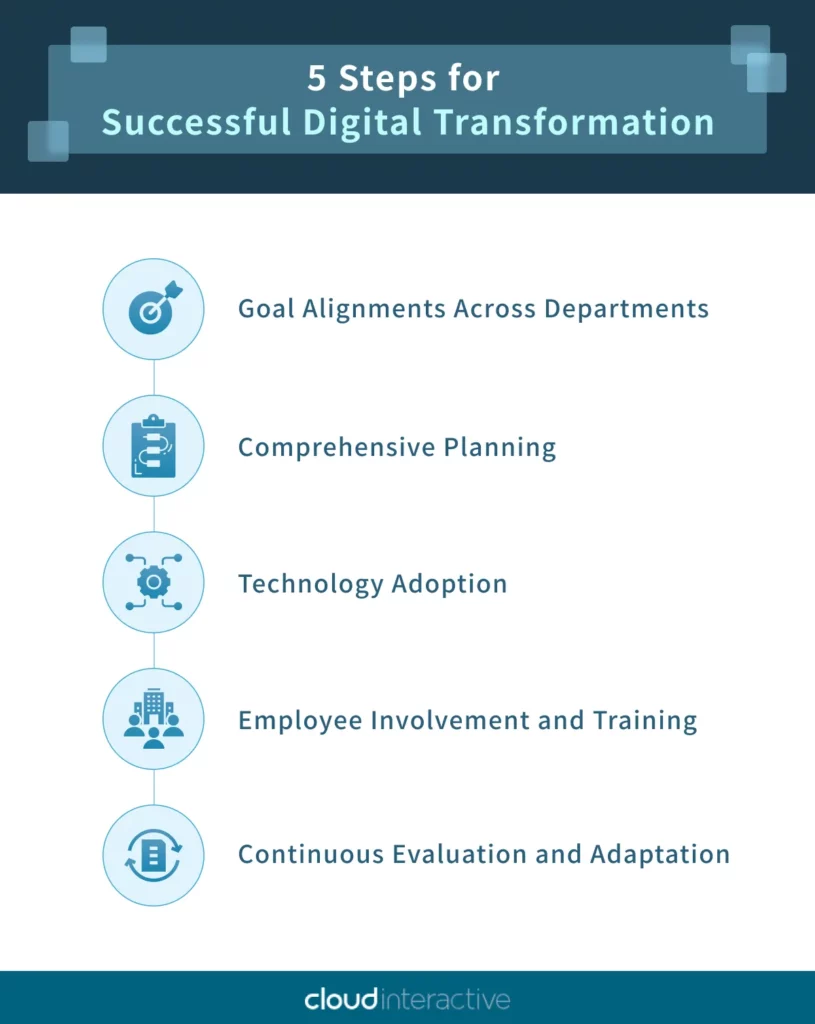
Digital Transformation Success Factors: From Definition to Implementation
Explore the benefits and steps of Digital Transformation with real-world examples. Elevate your business with our expert Digital Transformation Services.
Digital transformation is often misconstrued as simply shifting from physical to online operations. Many businesses mistakenly believe that adopting digital tools equates to achieving digital transformation. However, the reality is more nuanced.
In this blog, we break down the complexities and explore the strategic aspects of adopting digital technologies in today’s business world. From fundamental concepts to real-world case studies, we also highlight the role of digital transformation services in assisting the journey.
Whether you’re a seasoned professional seeking deeper insights or a newcomer eager to understand the basics, our blog is your go-to resource for exploring the transformative power of digital tools.
What is Digital Transformation?
To kick things off, digital transformation is about seamlessly integrating digital technologies into various aspects of a business – from business models and operational processes to customer experiences, organizational management, and culture. It’s like adding a dash of digital magic to reduce human effort, time, and costs, thereby increasing internal efficiency, external customer service, and overall satisfaction.
Common Misconceptions: Digitalization vs Digital Transformation
During the COVID-19 pandemic, businesses rapidly shifted their operations online. However, this reactive approach, without detailed planning, often resulted in merely adopting digital tools rather than truly transforming their processes. Simply put, digitizing tools and methods aren’t the same as accomplishing a comprehensive and effective digital transformation.
To achieve a successful digital transformation, companies must thoroughly evaluate their current operations and workflows, develop a comprehensive digital transformation strategy, and involve employees at all levels in its execution. Identifying and addressing challenges during the implementation process is crucial for adjusting the digital transformation strategy and tools, ensuring that digital systems truly serve the people within the organization.
Beyond 2023: Trends and Technologies Shaping Digital Transformation
As we move into 2024, the digital transformation landscape continues to evolve with cutting-edge advancements. Hybrid work models, intelligent search capabilities, Customer Data Platforms (CDPs), AIOps, machine learning, and integrated platforms connecting Agile, DevOps, and ITSM are emerging as key innovations that shape the future of digital transformation technology. These developments position organizations to leverage advanced technologies for enhanced operational efficiency and strategic growth.
4 Advantages of Digital Transformation
1. Real-time Data Collection and Analysis
Digital transformation enables businesses to collect and analyze real-time data, facilitating quicker decision-making and adjustments to operational strategies in response to market changes.
For instance, a Customer Management System (CMS) can provide instant updates on multi-channel sales performance, allowing businesses to adjust inventory levels and plan promotions accordingly.
2. Reduction of Repetitive Tasks
For example, an electronic approval system streamlines document approval by providing a digital platform for submission. Users receive automated notifications, allowing them to review and approve documents digitally. This eliminates physical paperwork, accelerates the process, and maintains an audit trail for transparency and accountability.
3. Workflow Standardization for Quality Management
Digital enterprise transformation replaces traditional communication methods, prone to errors and delays, with well-defined and clear workflows. This significantly reduces the likelihood of mistakes and streamlines interdepartmental communication, enabling decision-makers to manage work processes more effectively.
4. Better Service Delivery with Happier Customers
By freeing employees from administrative tasks, businesses can focus on enhancing their products and services. These digital systems enable customers to access self-service experiences. At the same time, robust data collection allows businesses to analyze and optimize marketing strategies, ensuring the delivery of products and services that align seamlessly with customer expectations.
Contact Us
If you are looking for Digital Transformation Services, click the button below to contact us. Our consultants will be in touch with you shortly.
Three Phases of Digital Transformation
Digital transformation typically unfolds in three interconnected phases, each representing a distinct facet of organizational evolution.

1. Digitization
Digitization is a fundamental aspect of digital transformation, representing the initial phase in which analog processes are transitioned into digital formats. In the business context, this involves integrating digital tools to optimize operations and enhance overall efficiency.
2. Digital Optimization
At this stage, organizations understand the available technologies better and optimize and reorganize their business processes. They leverage data analytics to gain insights into customer behavior, market trends, and internal processes. This data-driven approach helps identify areas for improvement and informs strategic decision-making.
The main difference between digitization and Digitalization is that digitization focuses on information, while Digitalization encompasses processes and people. However, the business models remain unchanged.
3. Digital Transformation
The final digital transformation phase represents a comprehensive shift in organizational mindset and culture, facilitated by digital technologies. This stage involves strategically reimagining business models, customer experiences, and value propositions, often by leveraging emerging technologies such as artificial intelligence and the Internet of Things.
Simply put, these are the core three phases a business must go through to drive innovation and successful transformation. Digitization (Stage 1) and Digitalization (Stage 2) focus on improving and optimizing existing processes. The final stage is where new possibilities and transformational strategies take place.
To achieve a successful outcome, businesses must go through all three stages. A successful digital transformation is not just about integrating digital tools but also a profound shift in mindset and culture, emphasizing agility, customer-centricity, and continuous improvement.
Four Types of Digital Enterprise Transformation
So, what are the types of transformations businesses have taken? Businesses have embraced digital transformation across processes, models, products, and organizational culture, showcasing the diverse ways digital technology can drive innovation and success.

1. Business Process Transformation
This involves automating and simplifying internal processes, such as warehouse management. For instance, integrating robotics into inventory management can improve accuracy and efficiency. Adopting automation technologies exemplifies how companies can leverage digital advancements to optimize and enhance their internal processes for improved performance.
2. Business Model Transformation
The transformation involves using digital technology to modify conventional sales approaches.
For example, in the past, the entertainment industry relied on selling physical DVDs to distribute content. However, with the advent of digital technology, companies embraced a new business model by offering online streaming services. By leveraging digital platforms, companies in the entertainment sector have redefined their revenue streams, adapting to evolving consumer preferences and market dynamics. This transformation underscores the power of digital technology in reshaping established business models for greater relevance and competitiveness.
3. Product Transformation
Companies can use digital technology to develop new products or services. A notable illustration of this is Amazon’s foray into cloud computing services through Amazon Web Services (AWS). In this case, Amazon leveraged digital technology to transform its business model, offering various cloud-based solutions and services. AWS expanded Amazon’s revenue streams and revolutionized how businesses approach computing resources, emphasizing the transformative potential of using digital technology to introduce innovative products and services.
4. Organizational and Cultural Transformation
Organizational and cultural transformation is a crucial yet abstract aspect of digital transformation. For a company to achieve its digital transformation goals, it must also achieve organizational and cultural transformation.
To achieve transformation, engaging employees at every level of the organization is vital. Creating a positive atmosphere that encourages collaboration across departments helps employees work together towards a common goal.
Five Strategic Steps for Successful Digital Transformation

Step 1. Goal Alignments Across Departments
A commitment from leadership is essential for the success of digital enterprise transformation. Leaders must communicate the benefits, goals, and expected changes resulting from the transformation. Aligning goals through clear communication serves as a guiding light for all departments, fostering a shared understanding of the transformation’s purpose and its potential impact on various facets of the organization.
Step 2. Comprehensive Planning
A well-thought-out plan is crucial for successful digital transformation. The plan involves evaluating current processes, setting goals, identifying digital tools, allocating resources, and establishing a timeline for implementation.
A realistic and achievable roadmap is crucial for successfully implementing digital initiatives in an organized manner, without disrupting regular business operations. Organizations can establish a strong foundation for a successful digital transformation by carefully addressing each element during the planning stage. This approach minimizes risks and maximizes the potential benefits of adopting digital technologies.
Step 3. Adopt technologies
Once the planning is complete, businesses can prioritize adopting digital tools based on their current operational needs. For enterprises focused on improving performance, it is advisable to initiate the transformation from the sales perspective, enhancing product inventory management, sales analytics, and customer data integration.
Step 4. Employee Involvement and Training
Invest in training programs to upskill employees while reducing resistance and fostering a culture of continuous improvement. This step ensures a smoother transition and fosters a workforce that is adaptable, engaged, and ready to embrace ongoing technological advancements.
Step 5. Continuous Evaluation and Adaptation
Businesses should always measure key performance indicators, analyze user feedback, and assess the overall impact of digital initiatives on organizational processes and objectives.
Digital transformation is an ongoing process. Regularly evaluating the effectiveness of implemented digital tools and strategies allows room for adjustments, ensuring alignment with the evolving landscape of business goals and market conditions.
Success Stories of Digital Transformation
In the realm of digital transformation, three distinct industries showcase their success stories:
Digital Transformation in Healthcare | Seamless Health Check Management System
Individuals used to face the inconvenience of calling the health clinic or queuing on-site to book health checkups. The process involved manual form-filling, resulting in a poor patient experience. To address this issue, the health clinic partnered with Cloud Interactive for a comprehensive transformation in the health checkup booking process and patient engagement.
With our expertise in interface design, we conducted surveys to understand user habits and behavior. Using this information, we developed an intelligent health check management system that enables patients to schedule health checkups online, complete forms online, receive appointment reminders, and access historical health check reports.
As a result of digitizing the booking process, the clinic reduced patient waiting time by 20% and increased patient satisfaction by 75%.
Digital Transformation in the Industrial and Manufacturing Industry | Global B2B E-commerce for Quoting, Procurement, and Sales
Historically, a leading global petrochemical manufacturer faced inefficiencies due to reliance on traditional communication methods such as phone calls and emails. The process resulted in scattered data, hindering the streamlined tracking of procurement progress and order statuses.
Within this integrated framework, the enterprise gains transparent insights into product sales data and order statuses. Simultaneously, customers can track order processing and monitor logistical dynamics. This establishment cultivates a mutually beneficial commercial platform, fostering collaboration and efficiency for both enterprises and clients.
Digital Transformation in the Shipping Industry | Digital Ship Management System
In the shipping industry’s journey toward digital transformation, traditional practices were plagued by challenges such as scattered documentation and limited real-time updates, both online and offline. This fragmented approach made data retrieval difficult and hindered effective decision-making due to the lack of insights into operational status, particularly when the ships were at sea without an internet connection.
Cloud Interactive developed a custom digital ship management system to address these challenges by providing clients with real-time data updates, overcoming the obstacle of limited connectivity at sea. The system centralized the management and real-time updates of company personnel and vessel-related information. Additionally, the electronic transformation of 160 internal forms streamlined the approval process and enhanced document retrieval efficiency. Visualized data tables provide real-time updates, enabling management to monitor the operational status of all vessels on a single interface.
Interested in more digital transformation case studies?
Click the button below to learn more about our case studies.
Digital Transformation Service at Cloud Interactive
With a wealth of experience in customer service and global projects, Cloud Interactive meets diverse enterprise needs and focuses on delivering an exceptional user experience for your end users. We extend our commitment by providing thorough onboarding training and robust post-sales customer support. This comprehensive approach ensures that enterprises don’t merely achieve digitization or adopt digital tools; rather, they empower their workforce to understand and support the company’s digital transformation policy, progressively achieving authentic and meaningful digital transformation.
Our Advantages:
- Human-centered Design Philosophy: Our core design approach centers around enhancing the user’s interactive experience.
- Comprehensive Understanding: We thoroughly analyze current enterprise challenges and needs, utilizing surveys and user behavior studies.
- Open Communication: We collaborate closely with internal and external stakeholders, delivering timely recommendations for system updates to ensure stability and security.
- Flexible Development Approaches: We tailor our development methods to align with customer preferences, project progress, and specific project attributes. Our offerings include agile development for adaptable progress adjustments and the waterfall development method for detailed product planning and development processes.
Conclusion
Digital transformation is not only a technological shift but also a comprehensive organizational evolution. Successfully navigating this transformation requires collaborating with software development partners who can assist with strategic planning, leadership commitment, employee involvement, and a customer-centric approach. By understanding the importance of digital transformation, the common misconceptions, and the strategic steps involved, businesses can embark on a journey that enhances efficiency, customer satisfaction, and overall competitiveness in the digital age.
By Cloud Interactive
Meet the masterminds behind the curtain at Cloud Interactive. We're not just software developers - we're also a content crew fuelled by caffeine and a thirst for knowledge. We translate tech jargon into plain English, dissect industry trends, and craft helpful tips that are informative and engaging. So, buckle up and join us on a journey through the ever-evolving and exciting world of technology!


